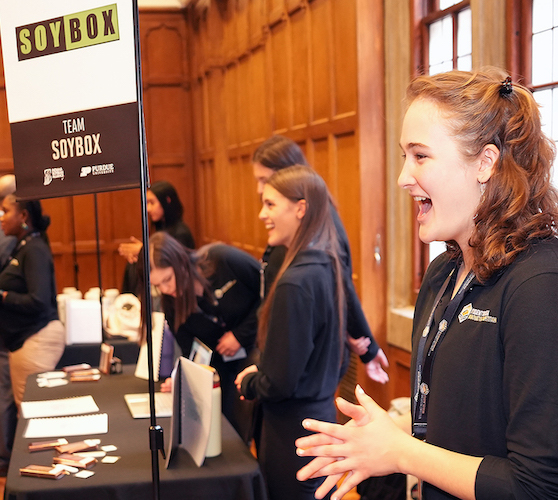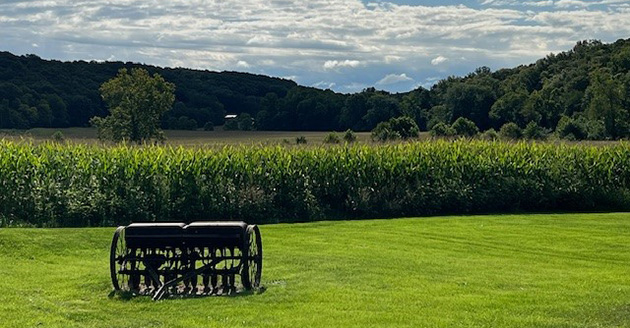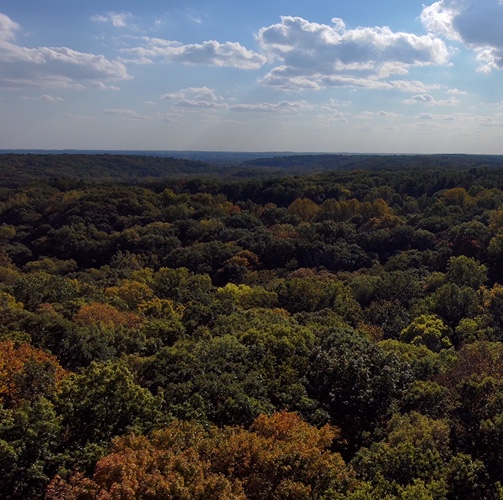Research is to see what everybody else has seen, and to think what nobody else has thought. – Albert Szent-Györgyi
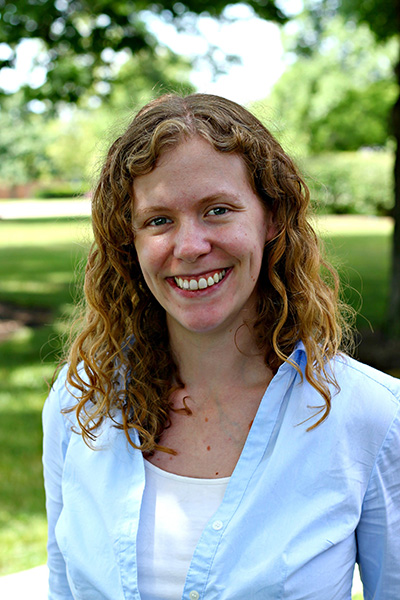 In high school, Zoe Almeida was interested in the natural sciences and marine research, drawn in by charismatic creatures like dolphins. That interest led her to study biology at Scripps College, from which she earned her undergraduate degree in 2011. Research experiences at Scripps laid the foundation for what has become a career in academic research. The Idaho native has gone on to earn a master’s degree at Purdue (Ecological Sciences and Engineering/Forestry and Natural Resources, 2016) and a PhD at Ohio State University (Evolution, Ecology and Organismal Biology/Aquatic Ecology, 2021). She is currently a postdoctoral scholar at Oregon State University.
In high school, Zoe Almeida was interested in the natural sciences and marine research, drawn in by charismatic creatures like dolphins. That interest led her to study biology at Scripps College, from which she earned her undergraduate degree in 2011. Research experiences at Scripps laid the foundation for what has become a career in academic research. The Idaho native has gone on to earn a master’s degree at Purdue (Ecological Sciences and Engineering/Forestry and Natural Resources, 2016) and a PhD at Ohio State University (Evolution, Ecology and Organismal Biology/Aquatic Ecology, 2021). She is currently a postdoctoral scholar at Oregon State University.
“I had some really good mentors in undergrad who made me passionate about asking questions and the process of answering them,” Almeida said. “I don't think I realized how much of science is iterative, where you don't really get that answer immediately. It's good if you like the process of looking for the answer.”
After completing her undergraduate degree, Almeida headed out into the field to gain experience while deciding if graduate school was the right place for her to continue asking questions.
First, she took a seasonal Guppy Mark/Recap Field Technician position at Foundations in Integrative Biological Research, where she carefully collected guppies from remote sampling sites and used elastomer mark/recapture procedures to mark and monitor growth and mortality rates.
The following year Almeida headed to Cordova, Alaska, to work as a fisheries technician at the Prince William Aquaculture Corporation. The position exposed her to egg take, out-migration, rearing and harvest of five species of salmonids. A chance encounter with a fellow researcher, one of 10 people working at the 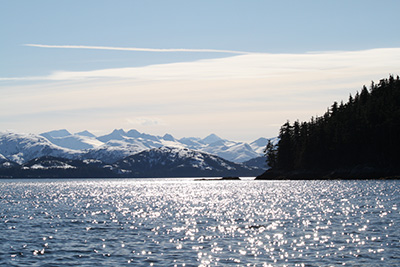 hatchery on Esther Island, would change the course of Almeida’s academic career and personal life.
hatchery on Esther Island, would change the course of Almeida’s academic career and personal life.
“When I was in Alaska, I met someone who had done his undergrad in fisheries and wildlife at Purdue, John Cannaday,” Almeida recalls. “I was explaining the types of things I was interested in, because I was more seriously thinking about applying to grad school. He told me that questions I was asking were right up the alley of Dr. Tomas Höök, and suggested I should email him. So that's how I got interested in Purdue and found my path there. John also ended up becoming my husband so it was a good experience all around.”
Almeida was interested in hypoxia, a phenomenon that develops in water bodies due to nutrient pollution but also happens naturally in marine and fresh water systems, where oxygen gets depleted, creating dead zones with very low oxygen levels.
 “When I was growing up, I remember hearing about a hypoxic zone off the coast of Oregon and I was really interested because it seemed like such a dynamic thing to try to understand how it's affecting not only organisms that can't move out of the low oxygen, but also fish that can move,” Almeida explains. “I was interested in Tomas's lab because he does work with hypoxia in Lake Erie. I was particularly interested in continuing work that a previous grad student of his had done that had showed that yellow perch in Lake Erie have this really interesting behavior where they dive into a hypoxic zone to eat their favorite food and then leave so that they don't have to stay in low oxygen conditions. I was interested in understanding how that affected yellow perch in Lake Erie and what that might mean for other populations when hypoxia does develop in Lake Erie.”
“When I was growing up, I remember hearing about a hypoxic zone off the coast of Oregon and I was really interested because it seemed like such a dynamic thing to try to understand how it's affecting not only organisms that can't move out of the low oxygen, but also fish that can move,” Almeida explains. “I was interested in Tomas's lab because he does work with hypoxia in Lake Erie. I was particularly interested in continuing work that a previous grad student of his had done that had showed that yellow perch in Lake Erie have this really interesting behavior where they dive into a hypoxic zone to eat their favorite food and then leave so that they don't have to stay in low oxygen conditions. I was interested in understanding how that affected yellow perch in Lake Erie and what that might mean for other populations when hypoxia does develop in Lake Erie.”
Almeida obtained a National Science Foundation Fellowship to fund her research, which allowed her to look at her hypoxia questions through both laboratory experiments as well as a habitat quality model. For some of her studies, she worked in conjunction with fellow master’s degree student Alison Hrycik (MS 2015), to collectively understand the non-lethal effects of hypoxia on fish. Their findings were published in the article “Sub-lethal effects on fish provide insight into a biologically-relevant threshold of hypoxia.”
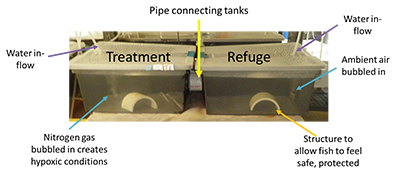 In her lab experiment, Almeida aimed to simulate the natural environment in which yellow perch can dive into a hypoxic zone to eat their food and then leave to breathe and digest it. Two tanks were connected, one contained food and the other did not. Once the fish had gotten used to the environment and knew they could move back and forth, researchers then randomly decided which one of those tanks to make hypoxic.
In her lab experiment, Almeida aimed to simulate the natural environment in which yellow perch can dive into a hypoxic zone to eat their food and then leave to breathe and digest it. Two tanks were connected, one contained food and the other did not. Once the fish had gotten used to the environment and knew they could move back and forth, researchers then randomly decided which one of those tanks to make hypoxic.
“We saw behaviorally how often they chose to be in the one that was hypoxic and whether it mattered if there was food in it or not,” Almeida said. “We exposed the fish to a chronic level of hypoxia to see how their physiology responded. Did it change certain parameters in their body? Were they acclimating to the hypoxia by changing the ways that they held onto the oxygen or did they have different responses that allowed them to tolerate these low oxygen conditions? We also experimented with a spike of low oxygen to see how they responded physiologically, simulating them diving into areas with low oxygen.”
Results showed that yellow perch juveniles didn't respond very much to hypoxia. Yellow perch are relatively tolerant of low oxygen. Behaviorally they didn't adjust what they were doing and they didn’t adjust their physiology that much to endure hypoxic conditions. One possible explanation, Almeida says, is that the temperatures where hypoxia develops are quite cold.
“In Lake Erie, hypoxia happens when the lake thermally stratifies and you have this warmer upper layer and this cooler bottom layer and they don't mix, so you get this sort of stagnant hypoxic zone on the bottom. This also means it's colder in the hypoxic zone and, when the water is cold, fish have slower metabolic rates,” Almeida explains. “They're using little energy and are not having to use a lot of oxygen. Then, they are pretty naturally tolerant of hypoxia. It helps explain a little bit of why they're a fish that can dive into a hypoxic zone because they're not necessarily experiencing as bad of consequences from that exposure.”
Findings were published in “Behavioral and physiological responses of yellow perch (Perca flavescens) to moderate hypoxia” and further described in an article Almeida wrote for The Fisheries Blog, titled “Yellow Perch and the Hypoxia Goldilocks Zone.”
Next, Almeida utilized a habitat quality model to answer the question of if the yellow perch and other species’ habitat quality changed when they experienced hypoxic episodes.
“The reason we wanted to understand this was because hypoxia develops naturally in many systems,” Almeida said. “However, the addition of external nutrients, things like fertilizer runoff that are high in nitrogen and phosphorus, can cause these hypoxic zones to last for a longer period of time, to be more oxygen depleted and to occur when they weren't necessarily naturally going to occur. A lot of studies that look at the negative effects of hypoxia are just looking at that low oxygen but they're not necessarily accounting for the fact that in order to get that low oxygen you also had an increase in prey. This research looked at really understanding this change and increase in prey communities and hypoxia, and what the tradeoffs were for four different species of fish.”
Those findings were recently published in an article in Freshwater Biology titled “Nutrient loading effects on fish habitat quality: Trade-offs between enhanced production and hypoxia in Lake Erie, North America.”
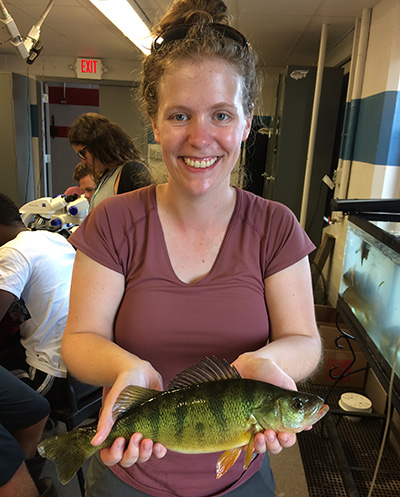 Research examined the tradeoffs from increased nutrients between hypoxia and prey for adult and juvenile fish from four species in Lake Erie, and found that increased phosphorus decreased overall habitat quality as hypoxia increased, and increased peak habitat quality (areas/times where prey abundance was already above average), but that responses were species and life-stage specific. Almeida also explained the research in an article for the Ohio DNR, “How is Fish Habitat Affected? Lake Erie’s Dead Zone.”
Research examined the tradeoffs from increased nutrients between hypoxia and prey for adult and juvenile fish from four species in Lake Erie, and found that increased phosphorus decreased overall habitat quality as hypoxia increased, and increased peak habitat quality (areas/times where prey abundance was already above average), but that responses were species and life-stage specific. Almeida also explained the research in an article for the Ohio DNR, “How is Fish Habitat Affected? Lake Erie’s Dead Zone.”
“We do see this tradeoff; it's not just add some, delete some, it's a little bit more complicated than that,” Almeida noted. “Hopefully people who are looking at the effects of hypoxia on Lake Erie and the nutrient reduction programs, can keep in mind that there are going to be these tradeoffs and fish might be able to utilize those areas that have pretty high resources and avoid hypoxia. We might not see as negative of consequences on fish populations as you would imagine. However, we did see the negative and positive effects of this tradeoff increase dramatically, depending on the ecology of the species.
“My research showed that nutrient abatement programs may not see rapid changes in habitat quality for a number of reasons, including the positive effects nutrients can provide for some species as well as the high influence of annual meteorological conditions (like what time of year do nutrients enter the system, temperature variation). That doesn’t mean that these abatement programs won’t eventually work, but it does mean that managers should be prepared to implement them for a long time before any benefits might be observed.”
The next step is to involve stakeholders to understand what matters to the communities who use the lake, and to address the different interests in the natural resource system and the affects nutrient increases can have on local residents, anglers and ecosystems.
“I would love to tell you this is exactly what we should do next, but I think it's quite complicated and I know a lot of people who are doing some really great research on the harmful algal blooms and different effects of nutrients, trying to consider those tradeoffs across all different stakeholder groups,” Almeida stated. “I'm hoping that understanding the way these things are interacting and affecting ecosystems in complex ways can allow others to take my research and use it to help answer those questions and get more specific as to what level we need to decrease nutrient loading to what is safe. That’s definitely a decision that needs to involve all the different fishermen and farmers and the people that live nearby.”
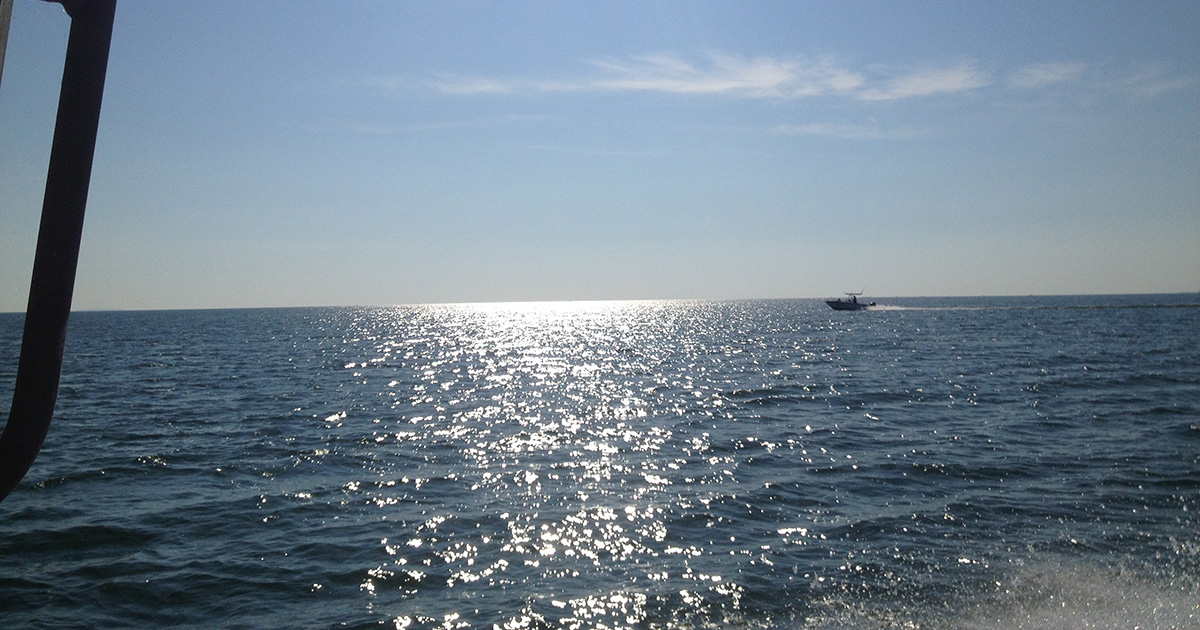 After completing her master’s degree, Almeida continued her research in the aquatic sciences in a PhD program at Ohio State University, looking at Walleye in Lake Erie, their early life history and how the environment they experienced early in life might affect individual fish as well as the population as a whole.
After completing her master’s degree, Almeida continued her research in the aquatic sciences in a PhD program at Ohio State University, looking at Walleye in Lake Erie, their early life history and how the environment they experienced early in life might affect individual fish as well as the population as a whole.
“If individuals have poor early life conditions, where they don't get enough food or they don't get enough of the right food, many of them are going to die,” Almeida said. “There's that immediate response but there's also the long-term response of what if they get just enough to survive, but they're not as healthy as they could be, how does that affect their growth? How does that affect the population as a whole later? My PhD work followed that cohort throughout the population to understand when we have these years of low or no ice and cohorts with poor early life conditions, what are the consequences for the wildlife population.”
Findings from Almeida’s PhD research, which was funded by the Ohio Department of Natural Resources, were recently published in the Ecology of Freshwater Fish in an article titled “Experiential legacies of early-life dietary polyunsaturated fatty acid content on juvenile walleye: Potential impacts from climate change.”
Climate warming and nutrient pollution may alter nutrition in early-life diets - having short and long-term effects on fish performance and recruitment. Even if diets improve, the diet received earlier in life can continue to affect individual performance. Researchers altered nutrition (polyunsaturated fatty acid, PUFA, content & vitamin E) in the first 10 days of life for Lake Erie Walleye, then provided high-quality diets for an additional 27 days. They found that after the 27 days of high-quality diets fish continued to be larger in the treatments that were originally fed higher PUFA. The lingering size effects may affect survival and performance later in life. This means that changes in lower trophic levels (like plankton) that affect nutrition for early life stages of Walleye could reduce the number of Walleye that survive to adulthood or could have other effects, like reducing the ultimate size of adult fish.
As a postdoctoral researcher at Oregon State, Almeida is studying early life history using fish otoliths, or stones in the inner ear that fish use for orientation and balance.
“In fish, they grow like tree rings,” Almeida explains. “They grow proportionally to the fish and you can use these layers to age a fish. You can see how many dark bands and light bands there are to figure out that was winter, and that was summer. With young fish, since they are depositing these daily, you can use them to age fish to the day, which is amazing. Otoliths brought me here. Also, similar to Lake Erie where you're seeing these winters where there's a lot less ice cover, the Gulf of Alaska has been experiencing similar warming periods, where there have been these extended periods where you have extremely warm conditions that are called marine heatwaves. We're trying to understand how these warming temperatures are affecting the Pacific cod population and in what life stage as well as what's going on with these young fish and how they are responding to the environment. We want try to get an idea of what impact these heatwaves have on this early life stage to get a better picture of what this means for that cohort as far as their contributions to the larger population.”
After completing her postdoctoral research, Almeida hopes to continue to answer questions that matter to humans and the natural resources they are using, whether that comes at an organization such as the National Oceanic and Atmospheric Administration (NOAA) or in an academic setting.
“My results aren't always as immediate as some people in our field,” Almeida said, “but I think understanding the systems, the ecology of human-caused changes, how natural systems work and how the changes that are occurring in these systems are affecting these species and populations can help us ask better questions and create deeper knowledge that can help us make better decisions and design better management plans for these populations in the long run.”
Almeida lives in Oregon with her husband John Cannaday, a researcher with the Oregon Department of Fish and Wildlife. A 2011 FNR alumnus, Cannaday completed his master’s at Clemson University in 2020 and has remained in the natural resources field. He is currently managing salmon and trout for the Oregon ODFW.
“Zoe was incredibly productive during her time as a MS student,” Hook said. “She not only completed two impactful research chapters for her thesis (both of which are now published), she also published two additional side-project studies, served as a TA, mentored an undergraduate researcher, produced multiple outreach publications, and developed a collaborative study with researchers in Sweden. All in all, she was awesome to work with as an advisee. Moreover, it’s been cool to watch her career continue to develop through her PhD research and now her postdoctoral position.”


